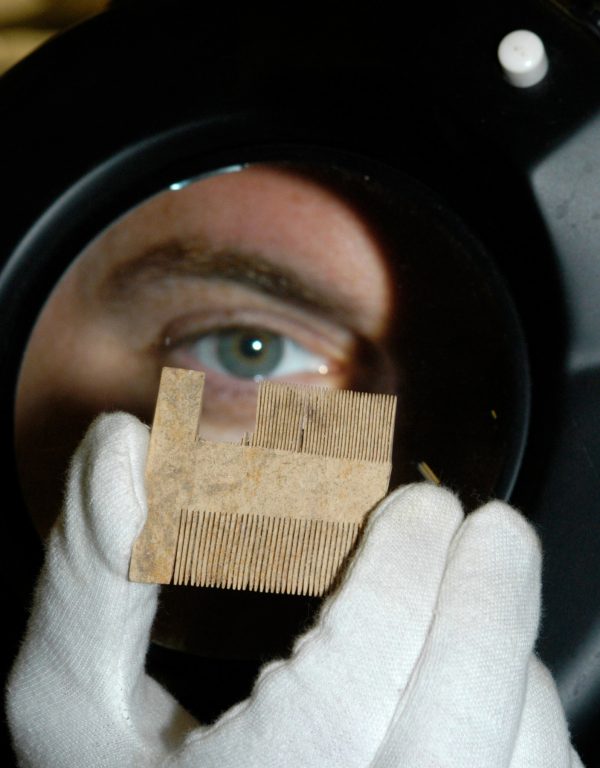New genetic research of human lice supports the evolutionary theory of direct contact between modern and archaic humans, according to a study lead by a Florida Museum of Natural History researcher. The study sheds light on a hotly debated topic in evolutionary biology: the origin of modern Homo sapiens.

Photo by Jeff Gage
Based on studies of the human head louse, Pediculus humanus, the study found that modern humans have two genetically distinct types of head lice. One is found worldwide and evolved on the ancestors of our species, Homo sapiens. The second type is found only in the Americas and evolved on Homo erectus, another early human species, but jumped to Homo sapiens about 25,000 years ago.
“I think it is amazing to know that we had physical contact with another species of human,” said David Reed, curator of mammals at the Florida Museum of Natural History and the lead author on the three-year study. “We either battled with them, or lived with them, or even mated with them. Regardless, we touched them, and that is pretty dramatic to think about.”
The study’s findings appear in the Oct. 5, 2004, online issue of the Public Library of Science journal, PloS, Biology. Reed completed most of the work while a postdoctoral fellow at the University of Utah along with colleagues there and at the University of Glasgow, Scotland, before coming to the Florida Museum earlier this year and finishing the study. Recent studies of the evolutionary history of other human parasites, including tapeworms and malarial parasites, fall in line with fossil and genetic data that place human origins in Africa. The new study confirms the “out-of-Africa” theory that the population of Homo sapiens mushroomed after a small group left Africa between 50,000 and 150,000 years ago. The new study also shows that human parasites, such as lice, have recorded events in human evolutionary history in their DNA, just as humans have.
Lice require direct physical contact between hosts for transmission because they are obligate parasites, meaning they can’t survive off that host. They also speciate each time the host does, Reed says, making them excellent markers for tracing man’s evolutionary history, which has a limited amount of fossil evidence.
Reed and colleagues analyzed the physical appearance and DNA of modern human head lice to construct their family tree. The DNA sequences of modern lice also were used to reconstruct their population histories over time. The researchers found the family tree of the lice closely mirrors the previously published family tree of humans and their primate ancestors. Scientists already believed that early ancestors of our species, Homo sapiens, diverged from other archaic humans about 1.2 million years ago. The new study showed two almost identical-looking but genetically different strains of head lice diverged about the same time. That indicates each of the two kinds of head lice infested a different species of early human as the human species diverged.
Genes from both types of head lice are found on people today, suggesting that after infesting Homo erectus for 1 million years, one type jumped from that soon-to-be-extinct species onto Homo sapiens. Mark Hafner, a professor of biological sciences at Louisiana State University who has been studying lice in rodents for 20 years, said it’s possible that both species of lice have been on the Homo sapiens lineage all along, but not likely.
“I think it’s an intriguing study using a blend of modern DNA analysis and more traditional parasitology,” Hafner said. “This is a very strong hypothesis. The transfer of lice from Homo erectus to Homo sapiens through direct contact is really the most simple explanation.” The study also supports the controversial view that there was a “bottleneck,” or reduction, in the global Homo sapiens population to about 10,000 people between 50,000 and 100,000 years ago. Some scientists believe a global volcanic eruption may have caused a mass die-off of early humans and created the bottleneck. Others believe the population bottleneck seen in human genes occurred because only a small group of human ancestors left Africa in the second wave 50,000 to 150,000 years ago, then reproduced to cause a sudden population expansion.
The new study used the mutation rate and comparisons of genetic differences among lice to find a similar population bottleneck in the group of head lice that infested early Homo sapiens, but not in the lice on the archaic human species. That means archaic humans didn’t go through the same population shrinkage and thus must have spread their lice to Homo sapiens sometime more recently than 50,000 years ago, Reed said. The findings provide independent confirmation of the out-of-Africa event because genetic analysis shows the population of lice – like their Homo sapiens hosts – also dramatically expanded after the bottleneck.
“When scientists first determined that we were contemporaneous with Neanderthals in Europe, it was suspicious that our contact with them immediately preceded their extinction,” Reed said. “Our study has provided evidence that we had contact with Homo erectus in Asia just prior to the extinction of that species as well.”